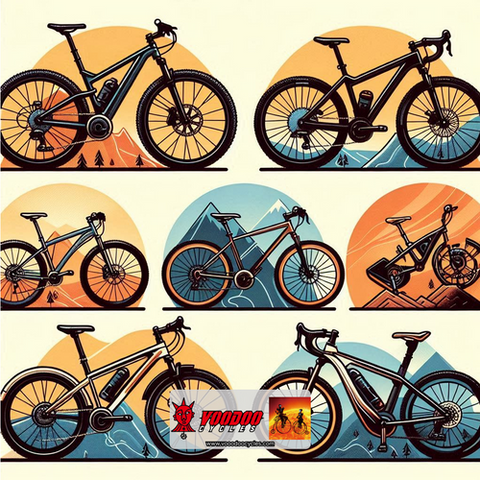
TL;DR
This guide breaks down five key bike types to help you pick the perfect ride. From rugged mountain bikes to speedy road bikes, we cover the pros and cons of each style. Whether you're hitting trails or cruising city streets, you'll find the ideal bike for your needs and budget.
What are the different types of bikes? What type of bike should I buy? What's the best type of bike? With so many bike types and options available, it can be difficult to find the one that suits your needs. This comprehensive guide'll explore the five most popular bike types and their key features. Whether you're a seasoned cyclist or just starting, we'll help you navigate the world of bikes and find the perfect companion for your adventures.
From mountain bikes to electric bikes, we'll discover the unique characteristics of each bike type, their design features, intended uses, and the factors to consider before purchasing. So, let's embark on this cycling journey together. In the following sections, we'll explore the world of mountain bikes, road bikes, hybrid bikes, gravel bikes, and electric bikes.
Mountain Bikes

Mountain bikes’ designs are catered to off-road cycling. They are characterized by their vigorous construction and their ability to tackle rough terrains. Mountain bikes come in a diverse range of styles tailoring to different riding experiences, including hardtail, full suspension, cross-country, trail, enduro, downhill, and fat bikes. The decision on the type of mountain bike to adopt is often dependent on the rider’s preferences and the type of terrain they intend on adventuring.
Types of Mountain Bikes

Hardtail Mountain Bikes
Characterized by their simple lightwe,ight design that features only a front suspension fork without rear suspension. It is a popular choice among cyclists for various disciplines, especially cross-country, trail, and enduro riders due to ,its lightweight making ,it more efficient for climbs.
When purchasing a hardtail mountain bike, it is essential to place focus on its tires and wheels, fork quality, and geometry. Wider tires allow for lower pressure and better grip. The decision between a 29-inch and a 27.5-inch will affect the bike’s speed and maneuverability. 29-inch wheels will be able to roll over obstacles more easily, while the 27.5-inch may offer a more playful and speedy ride. With forks being the primary source of suspension on a hardtail bike, forks with wider stanchions will provide better control during trail rides. In terms of geometry, most hardtails are designed for downhill or aggressive riding, so they feature slacker angles for stability, cross country models often offer steeper angles for climbing efficiency.
Full-Suspension Mountain Bikes
Equipped with both front and rear suspension, these bikes offer enhanced shock absorption and comfort on rough terrains, making them fitted for aggressive riding styles. It allows riders to tackle challenging and rough trails with greater ease compared to hardtail bikes, which only have front suspensions but with the trade-off of being heavier. More and more modern full-suspension bikes are starting to feature advanced frame designs, such as a high-pivot system that improves performance by enhancing traction and stability. Sames as hardtail mountain bikes, the common wheel sizes are 29 inches and 27.5 inches, with larger wheels rolling over obstacles easier and smaller ones more agile with more speed.
Cross-Country (XC) Bikes
Among the lightest types of mountain bikes, XC bikes are designed for the discipline of cross-country cycling with an emphasis on speed, efficiency, and endurance on various terrains. Most XC bikes feature around 100mm of suspension travel, with some recent designs offering up to 120mm. XC bike geometry is designed for the balance between comfort and performance, allowing efficient climbs and nibble handling of descents. It can come in both hardtail and full-suspension, with the full-suspension models becoming more popular recently due to their ability to handle technical trails while maintaining speed. Since its inception, XC bikes have evolved significantly with the introduction of advanced materials and technologies.
Trail Bikes
Designed for versatility, trail bikes allow riders to conquer a variety of terrains. It usually features a balance of suspension, geometry, and components that make it suitable for both uphill and downhill riding. Most trail bikes have a suspension travel of between 120mm and 160mm at the front. Their frame is often made in carbon or aluminum for their lightweight, aluminum being the more affordable and durable option with the trade-off of being heavier. Modern trail bikes have evolved significantly, offering enhanced capabilities without compromising climb performance.
Downhill Bikes
Downhill bikes are uniquely designed for high-speed descents on rugged terrain. Most downhill bikes feature a long travel suspension system (typically around 200mm to 210mm for both front and rear), allowing for better absorption of shocks from jumps and rough terrain. The frame is usually made from carbon fiber or aluminum, with the frame geometry being optimized for stability and high speeds.
Enduro Bikes
A specialized category for mountain bikes designed to excel in both climbing and descending, bridging the gap between downhill and trail bikes. Most enduro bikes feature suspension travel ranging from 150mm to 180mm, which enhances their shock absorption capability on rough terrains while staying efficient for climbing. Their geometry usually has a slacker edge angle and a longer reach compared to trail bikes. However, Enduro bikes are generally heavier due to their robust construction.
Fat Bikes
Also known as fat tire bikes, these bikes are specialized off-road bikes designed to accommodate oversized tires typically measuring 3.8 inches (97mm) or wider. Its engineering for low ground pressure allows it to traverse soft and unstable terrains such as snow, sand, bogs, and mud. Another characteristic that makes these bikes so special is that their wide tires can be inflated to pressures as low as five psi to provide a smooth ride over rough obstacles and enhance traction on challenging surfaces.
Buying Considerations
When buying a mountain bike, several key considerations should be taken into account. The first is suspension type, with options including hardtail (front suspension only) and full suspension (front and rear suspension). Choose based on your riding style and terrain preferences. Wheel size is another important factor, with common options being 27.5 inches and 29 inches. The rule of thumb is that larger wheels offer better traction and comfort over rough terrain, and smaller ones offer more agility and speed. Consider your intended use, whether it's cross-country trails, technical descents, or casual rides, as this will influence your bike selection. Finally, set a budget, as prices for mountain bikes vary significantly. There are budget-friendly options available without compromising too much on quality, allowing you to find a suitable bike within your financial constraints.
Explore our collection of mountain bikes by visiting our mountain spirits and warriors.
Road Bikes

Road bikes are specifically designed for speed and efficiency on paved surfaces. They are usually characterized by their lightweight frames (typically made from carbon or high-quality aluminum) and drop handlebars that provide multiple available hand positions for long rides. Their unique aerodynamic design characteristics, narrow tires, and lightweight frames make them the ideal choice for long-distance rides and competitive racing. The performance-oriented geometry enhances stability and responsiveness. To further reduce weight for easier acceleration, road bikes often feature lightweight components, including electronic or mechanical gearing systems for smooth shifting.
Types of Road Bikes

Racing bikes
These bikes are specifically designed for speed, agility, and performance during competitive cycling. They prioritize low weight, often using carbon fiber, to maximize speed and climbing ability. The aggressive geometry, with steeper angles for the fork and seat tube, shorter seatstays, and longer top tubes, promotes a lower riding position for reduced wind resistance. High-performance gearing with large front chainrings and closely spaced rear cassettes is optimized for rapid acceleration and high speeds on flat terrains. Aerodynamic features like deep-section wheels and integrated components further enhance speed. Modern racing bikes typically use disc brakes for improved stopping power and control, ensuring rider safety during high-speed descents or in wet conditions.
Endurance bikes
Designed for comfort and versatility; compared to race bikes, they have an upright riding position, shorter reach, and higher stack, reducing strain on the back and shoulders during long rides. Many models incorporate technologies like micro-suspension systems to absorb road vibrations, enhancing comfort while maintaining its lightweight characteristic. Wider tyre clearance allows for tyres up to 40mm, providing better traction and comfort on rough surfaces. Endurance bikes often include features like mudguard mounts, making them suitable for year-round riding, and can even handle light gravel riding. The gearing is generally lower than that of race bikes, with configurations like compact 50/34t chainsets and cassettes featuring 32-tooth sprockets, facilitating easier climbing on steep ascents. Common frame materials include carbon for lightweight performance and compliance, although alloy, steel, and titanium frames are also popular.
Aero Bikes
Aero road bikes are designed to minimize air/wind resistance and maximize speed. They utilize a truncated aerofoil shape, known as Kamm-tail, which reduces drag while maintaining frame stiffness. The aggressive geometry helps riders adopt a lower position, further reducing wind resistance. The integration of cables and components, along with deep-section wheels, contributes to the bike's overall aerodynamic efficiency. The primary benefit of an aero bike is the reduced drag that allows cyclists to exert less effort for the same speed. These bikes are advantageous in situations where aerodynamics plays a significant role in performance such as flat races and time trials. While optimized for flat terrains, many riders now use aero bikes in various race conditions due to their speed advantages.
Cyclocross Bikes
Designed for racing on mixed terrain, combining elements of road racing and mountain biking. These bikes typically have a lightweight frame made from carbon fiber or aluminum, with a geometry designed for quick handling and stability. The standard wheel size is 700c with tire widths generally between 32 mm and 35 mm, allowing for better traction on uneven surfaces while maintaining speed. Hydraulic disc brakes are standard, providing reliable stopping power in wet or muddy conditions. The gearing setup is crucial for cyclocross racing, with common configurations like a 46/36 chainring combination with an 11-36 cassette, allowing for smooth shifting and efficiency during high-intensity efforts.
Buying considerations
When purchasing a road bike, consider the fit, ensuring the bike aligns with your body size and riding style for optimal comfort and performance. Choose a bike based on your primary use, whether it's racing, commuting, or leisure riding. Budget is another important factor, as prices can vary significantly based on materials and components. Set a budget that aligns with your needs. Road bikes are an excellent choice for those seeking fast rides on paved surfaces. With various types available to suit different riding styles and preferences, it's essential to consider your specific needs when selecting the right model.
Explore the our road bikes by giving our road warriors a visit.
Learn more about professional road cycling from the sport's governing body, the UCI (Union Cycliste Internationale).
Hybrid Bikes

Hybrid bikes are versatile bicycles that combine features of both mountain and road bikes, making them suitable for a variety of riding conditions. They are designed to provide a comfortable and efficient riding experience, appealing to casual riders, commuters, and fitness enthusiasts. Similar to mountain bikes, hybrid bikes come in various types.
Types of Hybrid Bikes

Comfort Bikes
Designed to provide a smooth and comfortable experience whether navigating city streets or exploring country trails;.comfort hybrid bikes combine features from both mountain and road bikes. These designs prioritize comfort over speed, featuring wider tires and plush saddles. They are ideal for leisurely rides and recreational use.
Performance Hybrids
Performance hybrid bikes are designed to blend the best features of road and mountain bikes, making them versatile choices for both commuting and recreational riding. The design commonly features an upright riding position, flat handlebars, and a geometry that allows for efficient pedaling while maintaining comfort. This combination makes them suitable for various terrains, from city streets to gravel paths. A notable characteristic is its often feature of 700c wheels, offering a smoother ride on pavement while still being capable of handling light off-road conditions.
Cruiser Bikes
Ideal for leisure rides around the city, beach cruising, or commuting, cruiser hybrid bikes are designed for comfort and ease of use. These hybrid bikes combine features from both cruiser bikes and hybrid bikes, making them adaptable to various riding conditions.
Buying Considerations
When choosing a hybrid bike, consider your intended use, whether it's commuting, fitness, or leisure activities. Decide if comfort features, like wider tires, or performance aspects, such as lighter frames, are more important to you. If possible, test ride different models to find one that feels right in terms of size and handling.
Check out our hybrid spirits, it may be the perfect fit for you!
For information on cycling advocacy and infrastructure, check out People for Bikes.
Gravel Bikes

Gravel bikes are a drop-bar bicycle optimized for riding on mixed surfaces, including paved roads, gravel paths, and even forest trails. Similar to traditional road bikes, gravel bikes have wider tires (typically 30mm to 48mm) for enhanced traction and stability on uneven surfaces. Many models today also feature tubeless tires to prevent punctures. The geometry of gravel bikes is more relaxed than road bikes, with a longer wheelbase and slacker head tube angles. To enhance comfort during long rides, its taller head tube design places riders in a more upright position. With the design purpose of allowing rides to travel through various terrain without switching bikes, gravel bikes are the perfect option for adventure cycling, backpacking, or casual rides on mixed surfaces.
Types of Gravel Bikes

Gravel bikes come in various materials (carbon fiber, aluminum, titanium, and steel) and designs tailored to different riding styles
Adventure/Endurance Gravel Bikes
Designed for long-distance rides over various terrains, it features a relaxed geometry, wider tire clearance, and multiple mounting points for racks and bags. These are ideal for comfort during extended bikepacking trips and all-day explorations.
Race/Racy Gravel Bikes
Built for speed and agility on gravel roads, it features aggressive geometry, lightweight frames, and narrower tires. These are ideal for competitive riders in situations where performance is the priority such as gravel races.
All-Road Gravel Bikes
A versatile option that bridges road and gravel riding, it features a balanced geometry suitable for both surfaces, mid-width tires, and disc brakes. These are ideal for commuters and leisure cyclists who enjoy a mix of paved and unpaved routes.
Bikepacking/Touring Gravel Bikes
Specifically designed for carrying heavy loads over rugged terrain.These bikes feature robust frames with ample tire clearance and numerous mounting points for gear; making them ideal for multi-day adventures and self-supported expeditions.
Gravel Cyclocross Bikes
A gravel bike with cyclocross capabilities, it features an aggressive geometry with lightweight frames and ample tire clearance. These bike are idea for off-road racing events and spirited group rides where agility is key
Buying Considerations
When purchasing a gravel bike, consider your intended use, budget, frame material, components and specifications, and fit and comfort. Gravel bikes are designed for versatility, allowing riders to traverse various terrains. Establish a budget based on your needs, as gravel bikes can range significantly in price. Choose between aluminum or carbon frames, considering weight, comfort, and cost. Evaluate components like gearing, wheels, and brakes, selecting reputable brands and considering wheel size based on riding terrain. Ensure the bike fits your body size and riding style, and test ride different models to find what feels best. By carefully considering these factors, you can select the ideal gravel bike for your cycling adventures.
Adopt one of our gravel warriors or spirits to accompany you on your next ride!
For more information on gravel riding and events, visit Gravel Cyclist.
Electric Bikes

Electric bikes, commonly known as e-bikes, are bicycles equipped with an integrated electric motor that assists with pedaling. E-bikes represent a significant advancement in cycling technology, offering numerous benefits for both commuting and recreation. This technology is becoming increasingly popular among various demographics due to its versatility and convenience. E-bikes are suitable for commuting, leisure riding, and even off-road adventures, making them a compelling alternative to traditional bicycles and cars.
Classes of Electric Bikes

Electric bikes can be categorized into three main classes based on their motor assistance:
Class 1
Pedal-assist only; the motor provides assistance only while pedaling and stops at 20 mph.
Class 2
Throttle-assisted; these bikes can provide assistance without pedaling but are limited to 20 mph.
Class 3
Speed pedelecs; these have higher power and can assist up to 28 mph while pedaling.
Buying Considerations
Electric bikes offer numerous benefits, making them a popular choice for many. They enhance the commuting experience by providing assistance over long distances or hilly terrain, making it easier to carry loads or ride with extra gear. When selecting an electric bike, consider the motor power, measured in watts (W), which determines the bike's performance on inclines. The battery capacity, measured in amp-hours (Ah) or watt-hours (Wh), affects the range you can travel on a single charge. The weight of the bike, while lighter bikes are easier to handle and transport, may compromise durability. Finally, the braking system, with hydraulic disc brakes offering better stopping power than mechanical ones, is another important factor to consider.
Enjoy your next adventure across the terrains with one of our electric mountain bikes!
Conclusion
Choosing the right bike can significantly enhance your cycling experience. Whether you're a seasoned cyclist or a beginner, understanding the different bike types and their unique features is essential. In this guide, we've explored the five most common bike types - mountain bikes, road bikes, hybrid bikes, gravel bikes, and electric bikes.
Remember to consider your riding style, terrain preferences, and budget when making your decision. Each bike type offers distinct advantages, so take the time to research and test ride different options to find the perfect fit.
So, what are you waiting for? Start exploring the world of bikes and discover your perfect ride today! Let’s Cycle to Mars together.






